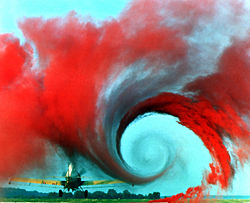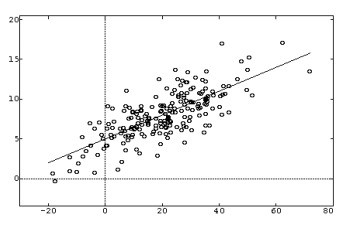- Air Homepage
- Global Warming
- Global Warming Articles
- Meteorology Articles
Get an article Meteorology students would enjoy
Want to see an article meteorology fans would appreciate? Here are a few groups that might find meteorological articles helpful:
People who like weather patterns, climate phenomena, or atmospheric processes may enjoy meteorological articles and may be fascinated by topics like severe weather events, forecasting techniques, climate change research, or unusual weather patterns. Forecasts, trends, and conditions can help outdoor enthusiasts plan their activities, prepare for potential weather hazards, and make informed decisions about safety and enjoyment.
You might find meteorological articles useful if you're hiking, camping, skiing, or boating. Agriculturists and farmers can benefit from meteorological articles. Climate data can be used to make crop selection, irrigation management, pest control, and harvesting decisions based on precipitation patterns, temperature variations, and growing degree days.
Researchers and scientists need resources in meteorology, atmospheric science, and climatology. They keep up with the latest advances, research methods, data analysis, and findings. Meteorological articles are great resources for students and teachers of meteorology, earth sciences, geography, and environmental studies. The articles can help them understand weather phenomena, climate processes, and how Earth's systems work.
For pilots, air traffic controllers, sailors, and maritime professionals, meteorological articles provide insight into turbulence, icing, storm systems, and ocean currents.
This newsletter isn't being produced anymore. Use the link on the right to see archive issues.
You can still get interesting air quality articles, which might help your research. You can skim them if you want.
You would have been able to get a monthly newsletter about a variety of weather and environmental topics, which will help you build your knowledge more quickly. I'd still like to help you understand these concepts so you know what surprises mother nature and the atmosphere might bring.
How? Find out how to boost your smarts by checking the newsletter chronicle. You'll be able to diagnose better and even make predictions.
Make sure you're prepared for emergencies too. You'll appreciate the world even more when you know how to interpret, explain and respect the intricacies of our environment. You're less likely to get anxious about environmental issues when they're in mainstream media.
You'll also know when news items are really important and deserve more attention. You might find out about:
- Jobs in meteorology,
- Satellites and radar,
- Global Warming essays and thoughts
- Schools like Hawaii Meteorology University,
- Scholarships and internships in meteorology
- Different meteorology topics have precise definitions.
This is a great chance to learn more about the air and become more knowledgeable. Using Google or Wikipedia, you can discover various topics that you want to dig deeper into. In addition, you'd learn how to talk about these things with skill, savvy, and finesse.
Meteorology: Insights and Opportunities
Talk about interesting stuff in the air.
It doesn't matter if your background and interest come from watching the Weather Channel on TV, the insights you'll gain from a newsletter like Blowin' in the Wind will be helpful. After getting a meteorology degree, some people might use this knowledge to decide what to do. Maybe they'll choose a different career. Then it's still a good choice.
I'd be stretching it if I said you'd be more fun at parties. But you never know. You'll get these short articles all at once.
So go ahead. Check the classic Article Meteorology catalog. See Blowin' in the Wind archives...
...for F R E E. Check these out right now...
Why Bother reading any such artices? Keep up with the latest: Article Meteorology journals provide the latest research. Keep up-to-date on meteorology advances, discoveries, and trends by subscribing to these journals.
Keep up-to-date on meteorology advances, discoveries, and trends by subscribing to these journals. You can expand your knowledge of weather and climate by reading meteorological journals. Learn about new theories, models, and concepts to better understand the complex interactions between the atmosphere, oceans, and land.
Opportunities for networking: Some meteorological journals offer networking opportunities. Read and comment on articles to connect with other researchers, practitioners, and experts.
Previous article Meteorology examples
First, some past issues
of the newsletter. And now other meteorological articles below on Stuff in the Air.
These website pages give technical explanations about weather:
RADAR - This is advanced RADAR technology that gives you more detailed and accurate weather info.
More Weather RADAR - A radar second article meteorology majors will appreciate
RADAR Weather Technical Descriptions - This is technical information about how RADAR works to detect and track weather patterns using radio waves and the Doppler effect.
National RADAR Problems - RADAR problems: This refers to challenges and issues related to using RADAR for weather forecasting, like the limited coverage of RADAR networks and interference from other sources.
Doppler RADAR - RADAR that uses the Doppler effect to detect precipitation and other atmospheric phenomena.
NOAA and GEOS Satellite Weather - Satellite weather is when NOAA and GEOS monitor and forecast weather patterns and conditions using satellites.
Satellite Photo Resolution - Image resolution refers to how detailed and clear satellite images of weather patterns are.
Satellite Wavelengths - The wavelengths used by satellites to detect and monitor weather patterns are called satellite wavelengths.
Wavelengths and Satellite Pics - Satellite pics and wavelengths: Different wavelengths can provide different types of information about weather patterns, like temperature, moisture, and wind speed.
Multi-color Satellite photos, images and pictures - Satellite photos, images, and pictures in multi-color: Satellite images that display weather data in multiple colors, like temperature, precipitation, and cloud cover.
Surface Weather Analysis Maps - Surface Weather Analysis Maps: These show current weather conditions, such as temperature, pressure, and precipitation, across a region.
Isobars and Air Pressure Science - Analyzing and forecasting weather patterns using isobars, which are lines connecting areas of equal air pressure.
Meteorology Terms and Physics Equations - The use of mathematical equations and terminology to describe and analyze weather patterns and conditions is called meteorology.
Upper Atmosphere Levels - Atmosphere levels: These are the different layers of the atmosphere above the Earth's surface, which affect weather.
Jet Streams - Weather patterns can be affected by jet streams, which are high-altitude, fast-moving air currents.
Atmosphere Layers - Different layers of the Earth's atmosphere, including the troposphere, stratosphere, mesosphere, and thermosphere.
Upper Ridges and Troughs - Ridges and troughs in the upper atmosphere can affect weather patterns and the movement of weather systems.
Upper Air Currents - Weather patterns and weather systems can be affected by upper air currents, which move in the upper atmosphere.
Advection - It's the movement of air masses that affects weather patterns across large areas.
Deformation - Weather systems can change shape or orientation, which can affect their movement and intensity.
Vorticity - Weather patterns can be affected by vorticity, which refers to the rotation of air masses.
Prevailing Winds - The dominant winds in a particular region or area can affect weather patterns and the movement of weather systems.
Find a more technical article meteorology readers will enjoy here:
Weather Instruments - Barometers, thermometers, and rain gauges are weather instruments used to measure and monitor weather conditions.
Barometers and Air Pressure - Weather forecasting relies on barometers to measure air pressure, which is an important factor.
Thermometers and Temperature Conversions - Another important factor in weather forecasting is thermometers and temperature conversions.
Hygrometers – Humidity Meters - Hygrometers measure how much moisture is in the air. Forecasters use them to predict precipitation and other weather events.
Weather Vanes and Anemometers – Wind Speed Instruments - Anemometers and weather vanes measure wind speed and direction. Predicting weather conditions and understanding how weather patterns will develop is important with them.
Rain Gauges - A rain gauge measures the amount of rain that falls in a particular area over time. They're used in weather forecasting and climate studies to understand precipitation patterns.
Current Weather Observations - Observations of current weather include temperature, humidity, wind speed and direction, and precipitation. Weather forecasts and alerts are based on this data, which is collected from weather stations, satellites, and RADAR technology.
Global Warming - Basically, global warming is the long-term rise in Earth's average surface temperature caused by human activities like burning fossil fuels, deforestation, and agriculture. Ecosystems, economies, and human societies are all at risk.
The problem with Global Warming - Global warming is causing significant and potentially irreversible changes to Earth's climate system. Changes include rising sea levels, heatwaves, droughts, and floods, and loss of biodiversity and ecosystem services. The impacts are already being felt around the world, and if greenhouse gas emissions don't get cut, they'll get worse.
Effects of Global Warming - Global warming affects the natural environment, human health, and socioeconomic systems. Precipitation patterns are changing, the ocean's rising, heatwaves and droughts are getting more frequent and severe, glaciers are melting, and plants and animals are shifting. There are also significant social and economic impacts of global warming, like more climate-related disasters, food shortages, and migration.
How do you stay informed about weather issues?
These archived articles on meteorological topics, including articles on air quality, should keep you entertained while providing some insight.
Do you have concerns about air pollution in your area??
Perhaps modelling air pollution will provide the answers to your question.
That is what I do on a full-time basis. Find out if it is necessary for your project.
Have your Say...
on the StuffintheAir facebook page
Other topics listed in these guides:
The Stuff-in-the-Air Site Map
And,
Thank you to my research and writing assistants, ChatGPT and WordTune, as well as Wombo and others for the images.
GPT-4, OpenAI's large-scale language generation model (and others provided by Google and Meta), helped generate this text. As soon as draft language is generated, the author reviews, edits, and revises it to their own liking and is responsible for the content.




New! Comments
Do you like what you see here? Please let us know in the box below.